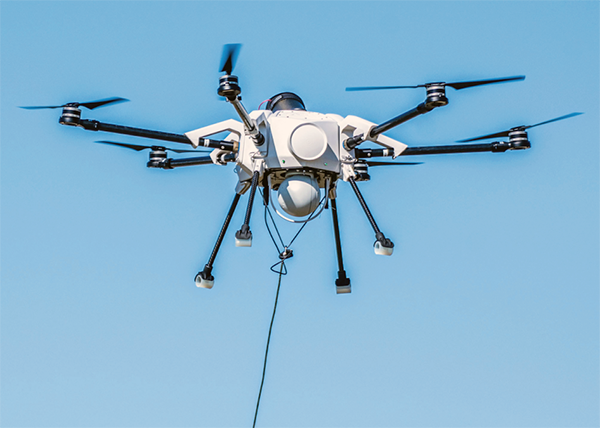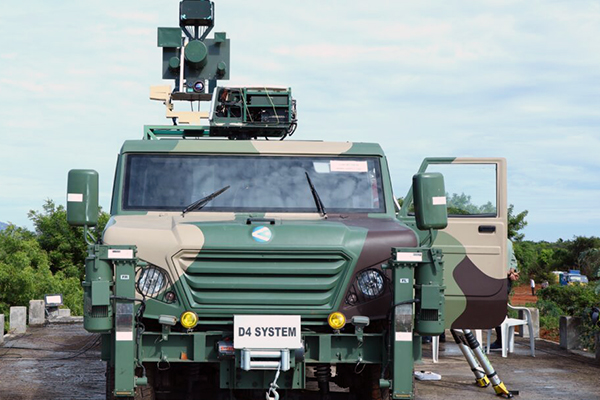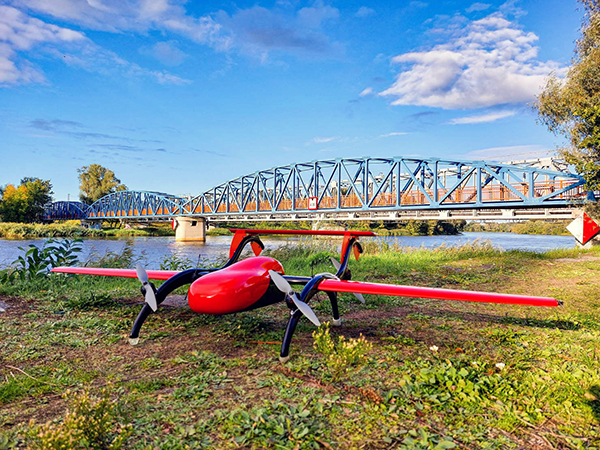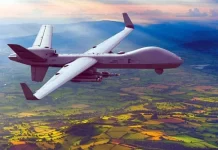T-Works Autonomous Hybrid UAV
T-Works, the Telangana government’s premier prototyping centre, has now successfully built and tested an autonomous hybrid unmanned aerial vehicle that can travel up to a distance of 45 km.
The model designed, developed and tested by T-Works can launch itself like a conventional drone and then fly forward like a conventional winged aircraft before making a landing vertically. Covering a distance of 45 km, it travelled for 33 minutes.
The airframe and its components were designed and fabricated using software design tools, 3D printing, laser cutting and CNC routing machines currently available at the Phase-0 facility in Begumpet, Hyderabad.
A hybrid UAV, the Airborne Medical Rapid Transport (AMRT25) has a wingspan of 2.5m. While its vertical take-off and landing (VTOL) motors are powered by a 10,000 mAh battery, the forward flight is powered by a 30 cc gasoline engine.
A press release from the office of the Minister for IT, Industries, and Commerce K T Rama Rao said the AMRT25 UAV, apart from the delivery of medical supplies, can be used for surveying, inspection, defence applications, surveillance and as a testbed for experimental payloads. “It completed over 30 test flights over a week passing various parameters such as maximum range, endurance, waypoint navigation and return-to-launch capabilities,” the statement said.
In comparison to a conventional multi-rotor drone, a winged UAV consumes up to 75 per cent less power as the wings help it produce additional buoyant force. The AMRT’s design helps it carry much heavier payloads over much larger distances. A 5 m X 5 m flat clearing is sufficient to safely launch and land the aircraft. The engineers are now planning the next version of AMRT that can travel a distance of 100 km with a payload capacity of 3.5 kg.
BEL develops UAVs to secure airbases, gather intel
Defence PSU Bharat Electronics Limited (BEL) has developed tethered Unmanned Aerial Vehicles (UAVs) which are ideally suited for applications that require more endurance. It is designed to secure airbases which, the officials pointed out, could prevent attacks like the one that took place at Pathankot Air Force Station in 2016. The UAV system can be used for aerial reconnaissance and intelligence gathering as well.
The system consists of a hexacopter, electro-optic payload, auto winching system with tether cable and a ground control station. “It can fly up to 100 metres in height and has electro-optical infrared (EO/IR) sensors. It is capable of surveying up to 2 km of radius in daylight and 1 km at night. It can take image snapshots at any time during the flight and the UAV system is built in a way to withstand harsh environments,” a BEL official said.
Powered by wired cables, it can fly for six hours and it requires an hour for the motors to cool down. If the power gets abruptly disconnected, in-built batteries can continue to power it for another five minutes.
The system can be effectively used for various surveillance and monitoring applications by enhancing its capabilities with the displacement of the electro-optic payload, and has the advantage of long detection ranges. BEL engineers started working on developing the UAV nine months ago.
The defence PSU is also developing Hexacopter-20, a multi-rotor UAV. It is a Medium Altitude Long Endurance (MALE) UAV capable of performing collaborative missions with other multicopters. Hexacopter can be customised to take and activate desired payloads like HADR (Humanitarian Aid and Disaster Relief), Light Detection and Ranging (LIDAR) and microphone depending on the applications required. It has a simple user interface, which can be handled by a single operator.
The UAV has been developed in association with a Bengaluru-based startup. Its capabilities were demonstrated to the Army and the Air Force, and BEL officials said they have expressed interest.
Drones with Hard kill and Soft Kill mechanism
In September, the Indian Navy signed a contract with the BEL for India’s first locally made naval anti-drone system (NADS) with “hard kill” and “soft kill” capabilities. These machines have been developed by the Defence Research Development Organisation (DRDO) and manufactured by the BEL.
The system comprises a radar that comes with 360-degree coverage with detection of micro drones up to 4 km and electro-optical/infrared (EO/IR) sensor which can detect micro-drones up to 2 km in select azimuth direction in clear weather. It has radio frequency (RF) detector with a detection capability of RF communication up to 3 km, radio frequency/Global Navigation Frequency Satellite System (RF/GNSS) jammer (jamming up to 3 km for RF/GNSS signals) and a laser-based hard kill system used to neutralise microdrones between 150 m to 1 km. The sensors are integrated through a command post.
Soft kill uses electronic warfare measures like jamming. “Under this, we can spoof enemy drones and misdirect them…” an official said.
BEL develops drone detection radar with 360-degree coverage
The Bharat Electronics Limited (BEL) has developed frequency-modulated continuous-wave (FMCW) drone detection radar to detect and track mini- and micro-class drones and UAVs. BEL officials said that they started working on the product nine months ago.
“It delivers a complete surveillance solution (search and track) to threats from drones/UAVs. The maximum detection range for micro drones are 1 km, mini drones are 2 km and small drones are 3 km. The operating temperature of the radar is -20 degree Celsius to +55 degree Celsius. This is a complete indigenous product developed at the BEL with no Transfer of Technology (ToT) from any other organisation,” the official said.
He further added that the drone detection radar (DDR) is capable of providing 360-degree coverage in azimuth. One of the advantages of the radar is that the transmitted power is low and this makes it LPI (Low Probability of Intercept) capable. “Due to its LPl capability, it is extremely difficult for intercept receivers to correctly identify the radar parameters and radar type. Its high processing gain and good range resolution enables very low radar cross section (RCS) target detection. It can also prompt other sensors like electro optical and laser to take countermeasures against the threat by providing target range, azimuth and elevation,” the BEL official explained.
The DDR is capable of monitoring a designated airspace day and night in all weather conditions. The radar can be controlled and operated remotely through wired communication. It is easy to deploy and can be carried in backpacks which makes it portable.
The officials say that the product is customisable. “This can be put on a vehicle, jammer and a gun. It has been tested with various flying objects and the capabilities have been demonstrated before the Indian Army and the Indian Air Force,” he said.
Drone manufacturing to attract Rs. 5000 cr investment
Ministry of Civil Aviation foresees an investment of over INR 5000 crore in the drone manufacturing industry over three years leading to annual sales turnover reaching over INR 900 crore in FY 2023-24.
Following this, Tata AIG General Insurance Co. Limited. announced the launch of Remotely Piloted Aircraft System (RPAS) Insurance and distribution ties up with TropoGo, a deep tech startup.
Tata AIG’s RPAS Insurance is a comprehensive product covering both Hull and Third-Party Liability risks faced by them. Tata AIG’s RPAS insurance also provides optional coverage for BVLOS operations, night flying, data loss liability etc.
With the influx of new and exciting drone technologies and the recent policy changes in India, the already highly active community of drone manufacturers, tech start-ups, and enthusiasts are excited to make India a drone hub by 2030.
“Driven by our core value of Customer First, we have co-created a market fit product with due consideration given to invaluable inputs from the Drone Federation of India (DFI). Our product fulfils the market requirement and is in line with the recommendations of the working Group formed by IRDAI of India on RPAS Insurance. We are confident that our RPAS Insurance product shall exceed the expectations of all stakeholders in the drone ecosystem.” said Sushant Sarin, President – Commercial Business, TATA AIG General Insurance Limited.
“The recent liberalisation of rules for owning and operating drones coupled with announcement of Production Linked Incentive (PLI) Scheme is an important milestone that will spur high growth of this segment. We are excited to have TropoGo as our distribution partner to fulfil the insurance requirements of drone owners and operators” added Sarin.
On the occasion, Sandipan Sen, founder and product owner of TropoGo, said, “We are extremely happy and excited with our association with Tata AIG General Insurance Co Ltd. Our alliance with Tata AIG further strengthens our capability to offer a comprehensive insurance cover for Drones. We strongly believe in fuelling the booming drone ecosystem by collaborating with industry leaders and a growing community of RPA Pilots to bring innovative product and tech solutions to them.”
European FIXAR ties up with Paras Aerospace
European commercial drone and software developer FIXAR, on 19 October, announced its entry in the fast emerging domestic unmanned aerial vehicle market in collaboration with Paras Aerospace, a subsidiary of Paras Defence. As a first step towards this partnership, the company will launch its flagship fixed wing drone FIXAR007 in the country, a release said.
The initial agreement targets delivery of 150 drones to the operators in India in the next 6-8 months with the first expected to arrive next month, it said.
These drones have applications in areas such as real-time video surveillance, laser scanning and aerial photography for various sectors including government, agriculture, security, surveying, among others, according to the release.
The FIXAR007 drone has demonstrated an increased flight length (up to 60km), a payload capacity of 2kg/4.4lb max, and increased stability compared to similar class drones.
As an end-to-end in-house product, FIXAR007 is adjustable to diverse market safety requirements making it promptly available in the market, it said. “We’re excited to enter the Indian market as it holds great potential. We estimate fast overall unmanned aerial vehicle (UAV) market expansion based on a liberalisation of Drone Rules in India, which eases user and operator access to unmanned aerial vehicles and allows the application of UAV solutions to a broader array of applications,” said Vasily Lukashov, founder-CEO, FIXAR.
The rapidly growing domestic UAV market is pegged at $ 1-billion in 2021 and further growth is estimated based on the increased drone applicability range, and new advanced UAV models developed to carry heavier payload and work in challenging and severe environments, it stated.
Both companies will collaborate to ensure access to efficient and cost-effective unmanned aerial solutions, offering a autonomous vertical take-off and landing model, FIXAR007 and a professional multirotor FIXAR INDOOR dedicated to indoor mapping, inspection, monitoring, surveillance, inventory, and exploration, as per the release.
Under the collaboration, Paras will support operations set-up, business development, and technical support for providing this future-ready technology, it said, adding, Paras Aerospace will be the Master Certification Compliance partner for FIXAR in India.
FIXAR is the platform with Fixed Angular Rotor Drone concept which will uniquely address this requirement. Paras Aerospace is looking forward to continued support from thriving businesses for industry leading drone solutions, he added.
Indigenous anti-drone tech soon: Amit Shah
Union Home Minister Amit Shah said that indigenously made anti-drone technology would soon be available to tackle the challenges faced by drones in areas bordering Pakistan.
Shah was speaking at the 56th Raising Day Parade of the Border Security Force (BSF) in Jaisalmer on 5 December. This is the first time that the Raising Day Parade of the border guarding force has been held outside Delhi.




















